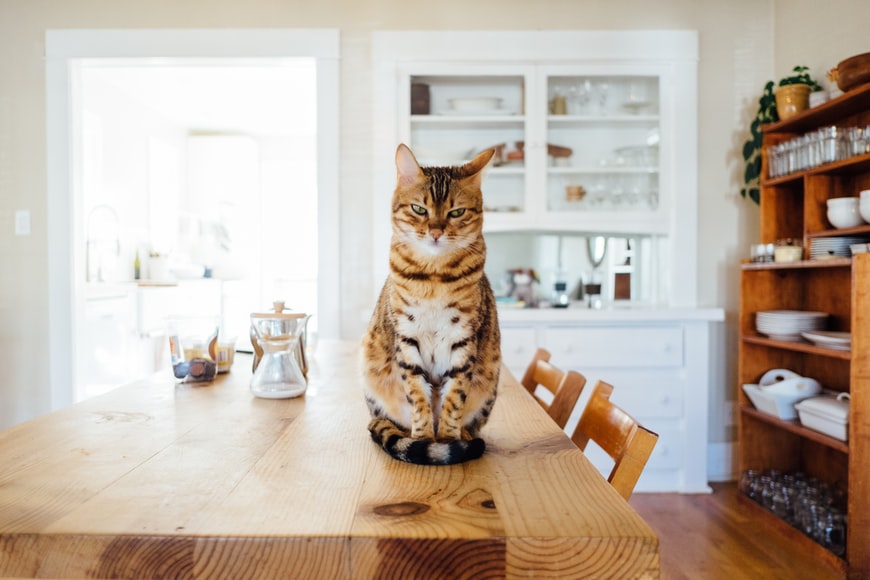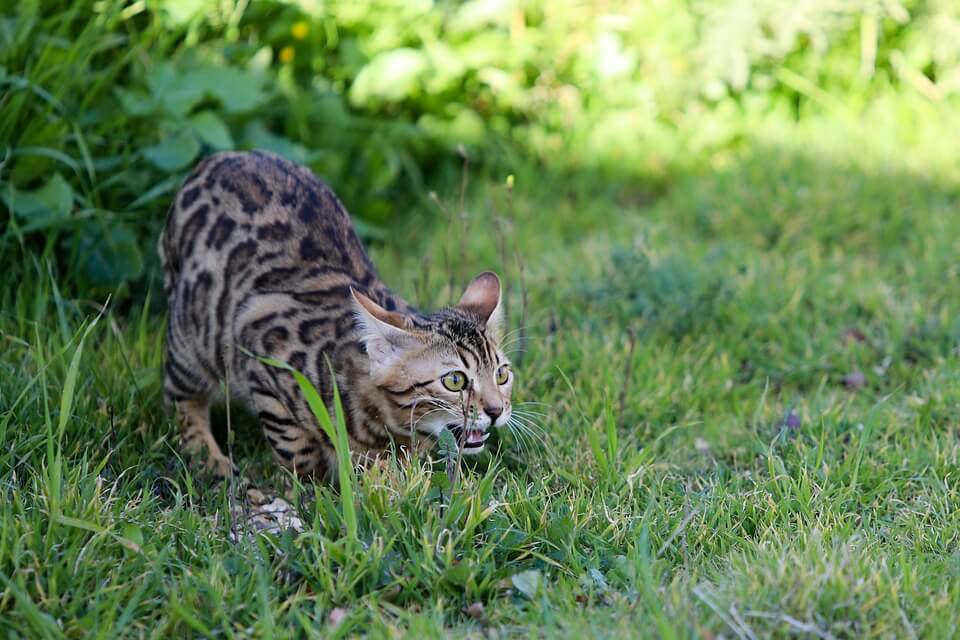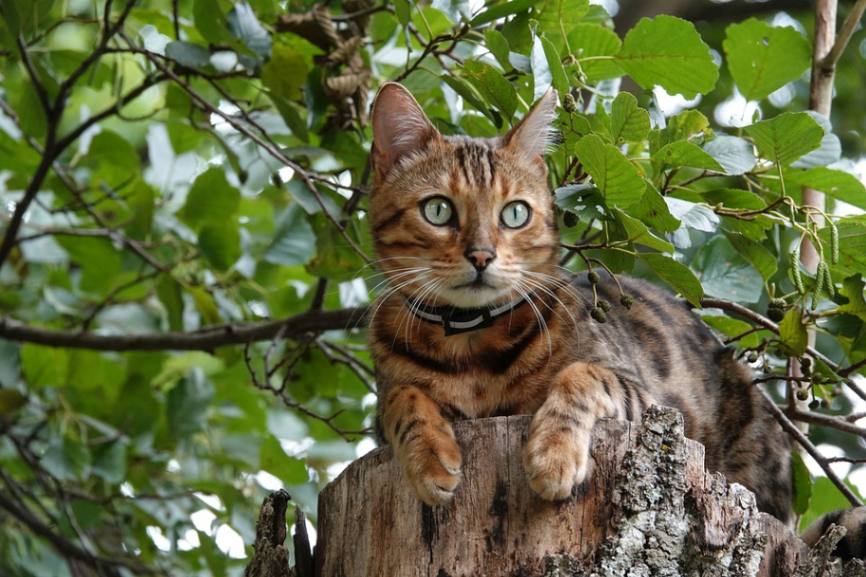Bengal Cat
Bengal cats are stunning, intelligent, wild-looking felines. Because of its patterns and personality, this hybrid cat breed is gaining popularity, and it is approximately the same size as a large domestic house cat.
If you want a cat with an exotic appearance but not the size or danger of a wild cat, the Bengal was created for you. This large-boned, shorthaired cat stands out for his spotted or marbled coat of numerous colors, created by breeding tiny Asian Leopard Cats with domestic cats.
Weight
- Male: 8-15 lbs
- Female: 8-15 lbs
Height
- Male: 13-16 inches
- Female: 13-16 inches
Lifespan
- 12-16 years
Appearance

Bengal cats are a slim, agile cat breed that weighs between 8 and 15 pounds. Their thick, short coats are coveted, vividly striped in varied brown, silver, and white hues. Their fur is very soft to the touch, like rabbit hair. Brown, yellow, orange, and green are the most frequent eye colors in Bengal cats.
The coat of a Bengal cat distinguishes them from other felines. Bengals are the only breed with rosette markings that reflect their wild Asian leopard origin.
Although Bengal cats weigh roughly the same as regular house cats, their long, muscular bodies appear bigger. And, because of their long legs, Bengals make superb jumpers, so don't be shocked if you discover your Bengal peering down from shelves and counters at you.
Temperament
The Bengal may look like a wild cat, but some say this breed is as lovably friendly as any domestic cat. Bengals are playful, gregarious, energetic cats with a generous dose of feline curiosity, full of life, and very people-oriented—fans of the Bengal rave about their personality and playful antics. Bengals form strong bonds of love and loyalty with their families, and become faithful, affectionate, fun-loving friends, provided you meet them halfway and give them the love they need in return.
The Bengal is highly active and highly intelligent. This makes him fun to live with, but he can sometimes be challenging. Overall, the Bengal is a confident, talkative, friendly cat who is always alert. Nothing escapes his notice. He likes to play games, including fetch, and he's a whiz at learning tricks. His nimble paws are almost as good as his hands, and it's a good thing he doesn't have opposable thumbs, or he would probably rule the world. Bored Bengal cats can also adopt some unconventional and slightly destructive habits,
Fond of playing in the water, the Bengal is not above jumping into the tub or strolling into the shower with you. Aquarium and pond fish may be at risk from his clever paws. Bengals relish their freedom; they dislike being held or restrained. This isn't unique to Bengals but to most very active breeds.
Bengals often love water, particularly if it's running. Some only dip an occasional paw under the faucet, while others may try to go for a romp in the tub or shower—as long as it's their idea. Some report that their cats' fascination with water borders on obsession, and steps must be taken to keep floods to a minimum; Bengal owners quickly learn to keep the toilet lid down.
Athletic and agile, Bengals love to climb and gravitate toward the highest point in any room. Bengals are often great sources of entertainment. They also love to climb and can often be found perching at the highest point they can reach in the home. A tall cat tree or two is a must for this feline, as are puzzle toys that will challenge his intelligence. On the rare occasions that they aren't swinging on chandeliers or swimming in your pool, the affectionate Bengal will be pleased to sit on your lap. He will share your bed. And yes, they will steal the covers.
One of the main characteristics that make them so special as companions are their intelligence. It's not surprising that Bengals are sharp as furry tacks since surviving in the jungle take wit and lightning reflexes. Bengals learn very quickly and enjoy learning new behaviors.
They may learn tricks you'd rather they didn't, such as turning on and off light switches, opening doors, and flushing toilets. The curious Bengal may get into everything, and changes in the home often provoke a quick response from the Bengal. Open a cupboard, and your Bengal may dive in for a look-see and will rearrange the contents if they're not up to his standards.
Living Conditions

When a Bengal cat is around you, he is happy. He doesn't mind living in a huge mansion or a modest apartment as long as you and your family are close by. However, no matter how little your area is, a Bengal needs plenty of things to do and climb. Bengals also will cuddle up on your lap for a comfortable nap after a long day of chasing and exploring.
This large cat should have at least one cat tree, as well as lots of toys to keep him amused while you're away. If you spend a lot of time away from home, owning a second cat might help keep your pet entertained and active.
Bengal cats have a strong hunting drive, and they like observing birds, squirrels, and other creatures from the safety of their own house. Installing a carpeted perch to provide him with a comfy observation place is a fantastic idea because of his love of chatting at the window. Just keep breakable objects off a shelf or mantel where your Bengal may reach them. Remember that because this breed is so elegant, your cat will inevitably investigate every high-up area they can reach.
Care

Bengals have a short, silky, smooth coat that maintains weekly brushing. They will appreciate the attention, and you'll notice fewer hairballs about the home if you brush them more frequently.
Brush their teeth with a vet-approved pet toothpaste at home regularly, and schedule veterinarian cleanings as required to prevent Periodontal disease. Daily oral hygiene is ideal but brushing once a week is preferable to nothing. Every couple of weeks, trim their nails.
To eliminate any discharge, use a soft, wet cloth to wipe the corners of your eyes. To avoid the danger of transmitting infection, use a different portion of the towel for each eye. Check the ears at least once a week. Wipe out the ears with a cotton ball moistened with a mild cleaner prescribed by your veterinarian if they appear filthy
Keep the litter box as clean as possible. Cats are picky about toilet hygiene, and a filthy box may drive them to utilize other house areas instead.
It's best to maintain a Bengal as an indoor-only cat to protect him from diseases carried by other cats, dog or coyote attacks, and other risks that cats encounter when they go outside, such as getting hit by a car. Local birds and wildlife are likewise safe from this enthusiastic hunter since he is kept indoors.
Build your Bengal a big outside area where he may safely jump and climb if at all feasible. Outside Bengals are also at risk of being stolen by someone who wants to buy one but cannot afford it.
Health
By creating an individual preventive health plan for your Bengal, maybe you can avoid certain foreseeable dangers in your cat. But both pedigreed and mixed-breed cats have different levels of health issues that might be hereditary. Bengals are typically healthy; however, they have been known to contract the following diseases:
- Flat-chested kitten syndrome is a moderate to severe malformation in kittens. When kittens reach adulthood, they generally exhibit no indications of their survival.
- Hip dysplasia can cause lameness in extreme instances.
- Patellar luxation is a genetic kneecap dislocation that can be minor to severe. Surgery can help in the most severe instances.
- Distal neuropathy is a nervous system disorder that causes weakness. It can strike Bengals as young as one year old. Many cats, thankfully, heal on their own, while a minority do relapse.
- Progressive retinal atrophy is a degenerative eye condition that affects the retina.
- Hypertrophic cardiomyopathy is a kind of cardiac disease that can be passed down the generations in particular breeds.
Although respectable breeders make every effort to keep their felines healthy and free of genetic diseases, you should be prepared for any problems that may arise during their lives. A pet insurance plan can help you prepare for any veterinary requirements your cat may have.
History

The Bengal cat is a cross between a domestic cat (Felis silvestris catus) and a leopard cat (Felis silvestris catus) (Prionailurus bengalensis). The leopard cat resembles a domestic cat except for the bigger, snapping eyes, prominent whisker pads, longer legs, and bright leopard-style patterns. It does resemble a little leopard.
The Bengal breed was born when a female leopard cat was acquired from a pet store. Leopard cats could be acquired at pet stores in the United States, unlike now. Due to the particular demands of these cats and state regulations, this is no longer the case. The leopard cat was not purchased to create a new cat breed; rather, Jean Mill wanted a one-of-a-kind companion.
Jean Mill, a California-based breeder, is credited with producing the first Bengal cat. In 1963, she created this breed by mating a Domestic Shorthair cat with an Asian Leopard cat. Bengal cats are therefore a relatively recent breed, especially when compared to Persian cats, whose origins date back to the 1600s.
TICA originally recognized Bengal cats as an experimental breed in 1983, and they were given full recognition in 1993. The Cat Fancier's Association recognized the Bengal cat as a breed in 2016. The American Cat Fanciers Association, the Canadian Cat Association, the United Feline Organizations, and the Governing Council of the Cat Fancy accept them for registration.
With their loving, intelligent personalities and eye-popping coat colors and patterns, it's no wonder that they've swiftly surpassed cats that have been around for centuries as one of the most popular breeds in the world.
Final Thoughts
Make sure you do your homework before deciding on a Bengal cat. Consult with other Bengal cat owners, trustworthy breeders, and Bengal cat rescue organizations. Check with your state and local governments before purchasing a Bengal cat or kitten, too; they are prohibited in several areas, including Hawaii and New York City. Bengals from the F1–F3 generation may be subject to additional limitations.








Comments